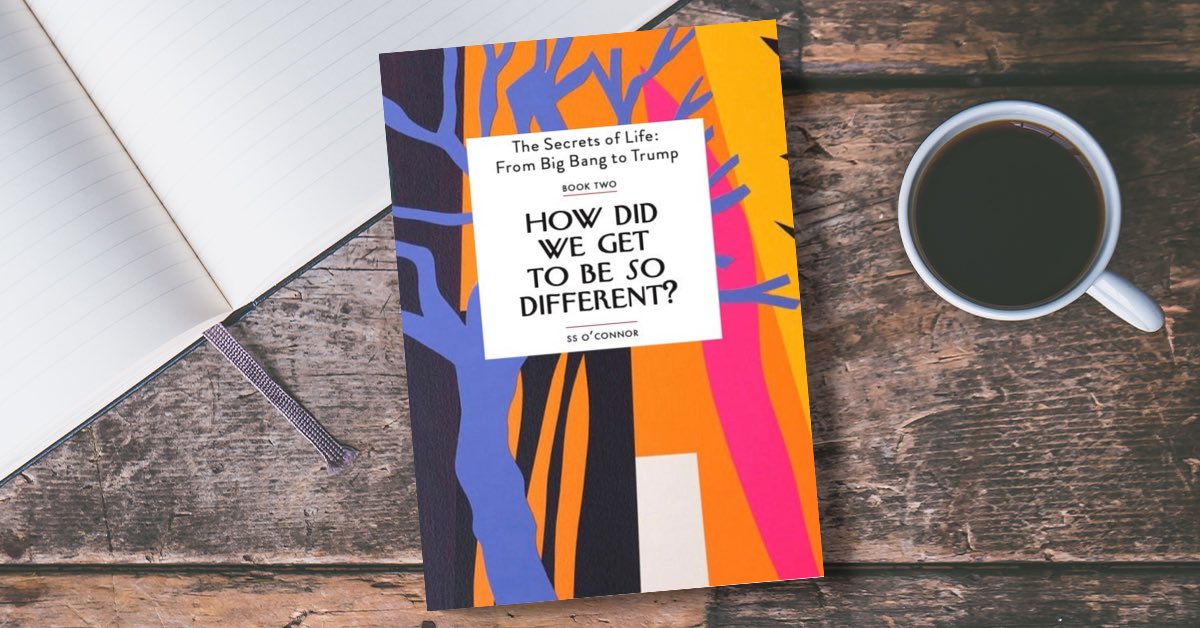Tell us more…
Book Two of SS O’Connor’s series ‘The Secrets of Life: From Big Bang to Trump’ is another rollercoaster ride through time. How did We get to be so Different (i.e. from other creatures) speeds through millennia of human evolution and society.
From hominins to Homo Sapiens – ‘us’ – it powers on through hunter-gathering, early farmers, the emergence of superstition and beliefs, and ‘Big Man’ systems of leadership, all the way to the French revolution.
The book’s a vivid read, salsa’d with anecdotes…mostly about ‘he’. Where’s the ‘Big Woman’? The emergence and diversity of Africa’s successful matriarchal societies, for example? Relying on the old writing convention that ‘he’ and ‘we’ simply blend-in or embrace an unmentioned ‘she’, has always risked missing some revealing avenues.
Biblical Eve does get a name-check; and there’s a suggestion that equal values might have been set on women’s and men’s roles in prehistory before farming (not snakes) caused things to go a bit pear-shaped for everyone – bringing harder work, more diseases, smaller adult body sizes, tougher childbirth, and shorter life-spans all round. And so farewell, ancient Eden. Millennia and many chapters later, women bob up in the book in their own right, in a couple of paragraphs on 20th century universal suffrage.
Meanwhile, the manly text has neatly summarised the arrivals of trade, money, counting and early writing systems, kings, war and conquest, the forming of ancient and other empires, and religious upheavals. It reaches a crescendo with the dramatic invention in Europe of the first printing presses, whose affordable pamphlets (the Twitter of the time) bursting with theories about society, and sometimes false news, bring revolution in their wake. No mention that some were also written by the women of the day. Book Two concludes by introducing a real Adam – Adam Smith, ‘father of economics’ .
Much work must have gone into this bold, sweeping panoramic shot at describing ‘us’, and what ‘he’ and ‘we’ did next – and it’s an interesting and handy read. Yet something’s amiss.
The inevitably-fogged lens of that ‘he-encompasses-she’ writing convention, and the book’s sheer narrative speed, do completely blur any ‘she’ contributions – which must in reality have provided active factors in humankind’s developmental mix – into a nameless and uncredited ghost, within an ‘us’ also called ‘he’ – and a Big Man. Us, we, he; but ‘she’ mostly doesn’t come into it. Bit unlikely.
I know it’s a lacuna by literary default – albeit one that, to me, feels lax and out of time – but it doesn’t really help this book’s chatty forays into what’s made humanity tick. The jaunty all-round use of ‘he’ soon feels both statistically and anthropologically jarring, disabling the text from fully delivering the vast story this author is tackling. Half of humanity’s contribution to its own kind’s progress feels veiled, or just plain missing in action. ‘Femina’ Sapiens today does not automatically think in exactly the same way as the ‘Homo’ of this ilk; nor credit all her ideas, inputs, skills and innovations to a shared name of ‘he’ . Book Two might gain from a few more paragraphs, from the questing mind of SS O’Connor, on theories or examples differentiating the nature and impetus of ‘her’ and ‘his’ inputs to our group social evolution thus far.
The process of pooling different approaches, or perhaps sharing by disputing, must also be part of how we all got this far, together. Two brains have probably been reckoned to be better than one for millennia – and long before literary conventions kicked in.

